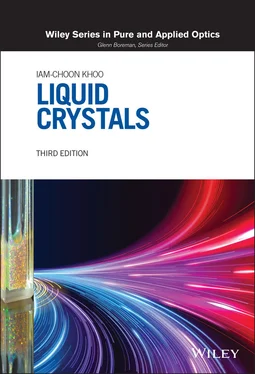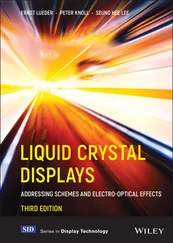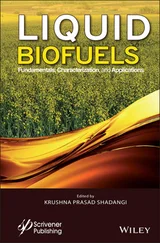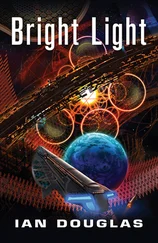Iam-Choon Khoo - Liquid Crystals
Здесь есть возможность читать онлайн «Iam-Choon Khoo - Liquid Crystals» — ознакомительный отрывок электронной книги совершенно бесплатно, а после прочтения отрывка купить полную версию. В некоторых случаях можно слушать аудио, скачать через торрент в формате fb2 и присутствует краткое содержание. Жанр: unrecognised, на английском языке. Описание произведения, (предисловие) а так же отзывы посетителей доступны на портале библиотеки ЛибКат.
- Название:Liquid Crystals
- Автор:
- Жанр:
- Год:неизвестен
- ISBN:нет данных
- Рейтинг книги:4 / 5. Голосов: 1
-
Избранное:Добавить в избранное
- Отзывы:
-
Ваша оценка:
- 80
- 1
- 2
- 3
- 4
- 5
Liquid Crystals: краткое содержание, описание и аннотация
Предлагаем к чтению аннотацию, описание, краткое содержание или предисловие (зависит от того, что написал сам автор книги «Liquid Crystals»). Если вы не нашли необходимую информацию о книге — напишите в комментариях, мы постараемся отыскать её.
Liquid Crystals,
Liquid Crystals
Liquid Crystals
Liquid Crystals — читать онлайн ознакомительный отрывок
Ниже представлен текст книги, разбитый по страницам. Система сохранения места последней прочитанной страницы, позволяет с удобством читать онлайн бесплатно книгу «Liquid Crystals», без необходимости каждый раз заново искать на чём Вы остановились. Поставьте закладку, и сможете в любой момент перейти на страницу, на которой закончили чтение.
Интервал:
Закладка:
If the dye molecules undergo some physical changes such as trans–cis isomorphism or produce space charges following photon absorption, they could give rise to nonlinear optical effects [16]; others [17] have shown that dye molecules deposited on the cell windows can be optically aligned as an effective means of surface alignment mechanism for LC cell fabrication. These and other effects due to the presence of dye molecules or other photosensitive agents in liquid crystals are discussed in more detail in Chapter 8.
1.4.3. Polymer‐dispersed and Polymer‐stabilized Liquid Crystals
Just as the presence of dye molecules modifies the absorption characteristics of liquid crystals, the inclusion of liquid crystals in the material of different refractive indexes modifies the light scattering properties of the resulting “mixed” system. A good example is polymer‐dispersed liquid crystals (PDLC) formed by introducing liquid crystals as micron‐ or sub‐micron‐sized droplets into a polymer matrix. The optical indices of these randomly oriented liquid crystal droplets, in the absence of an external alignment field, depend on the liquid crystal–polymer interaction at the boundary and therefore assume a random distribution (cf. Figure 1.18a). This causes large scattering [18]. Upon the application of an external field, the droplets will be aligned ( Figure 1.18b), and the system will become clear as the refractive index of the liquid crystal droplets matches the isotropic polymer backgrounds.
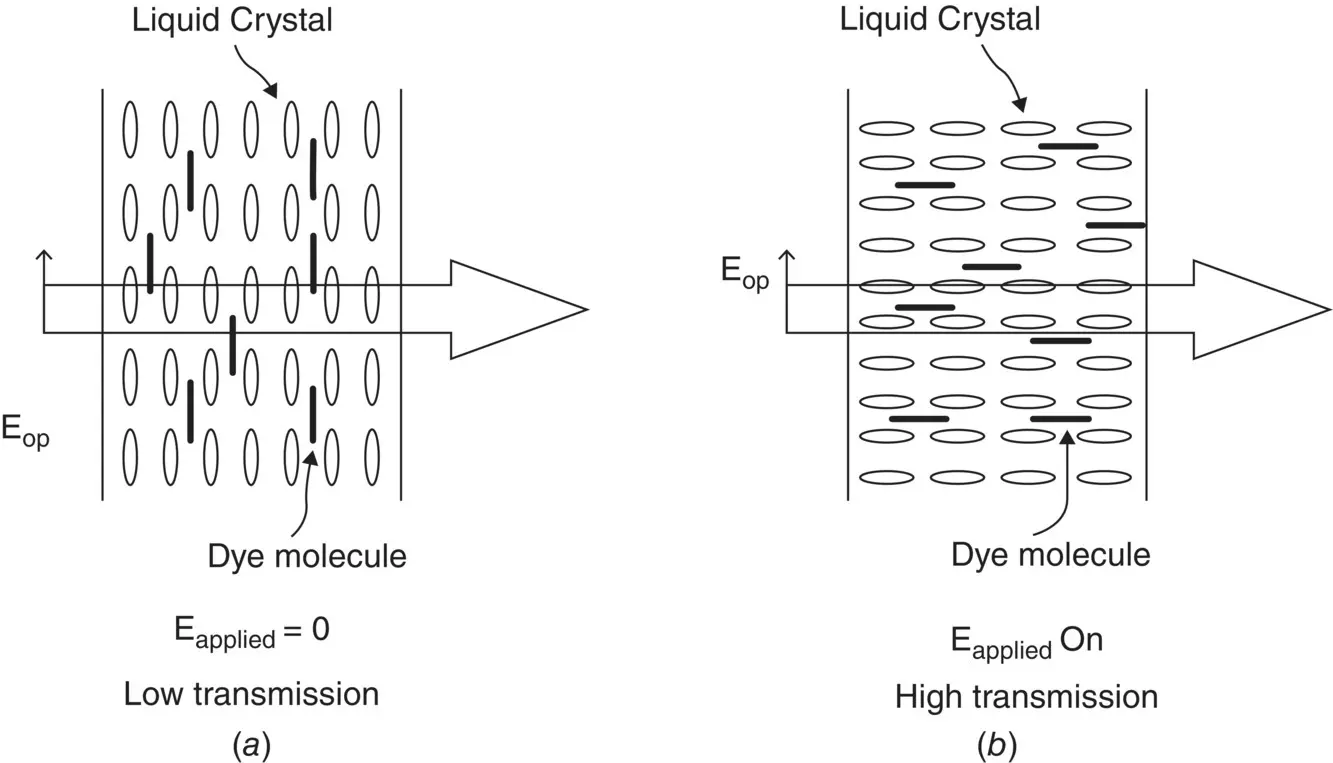
Figure 1.17. Alignment of a dichroic dye‐doped nematic liquid crystal: (a) before application of switching electric field; (b) switching field on.
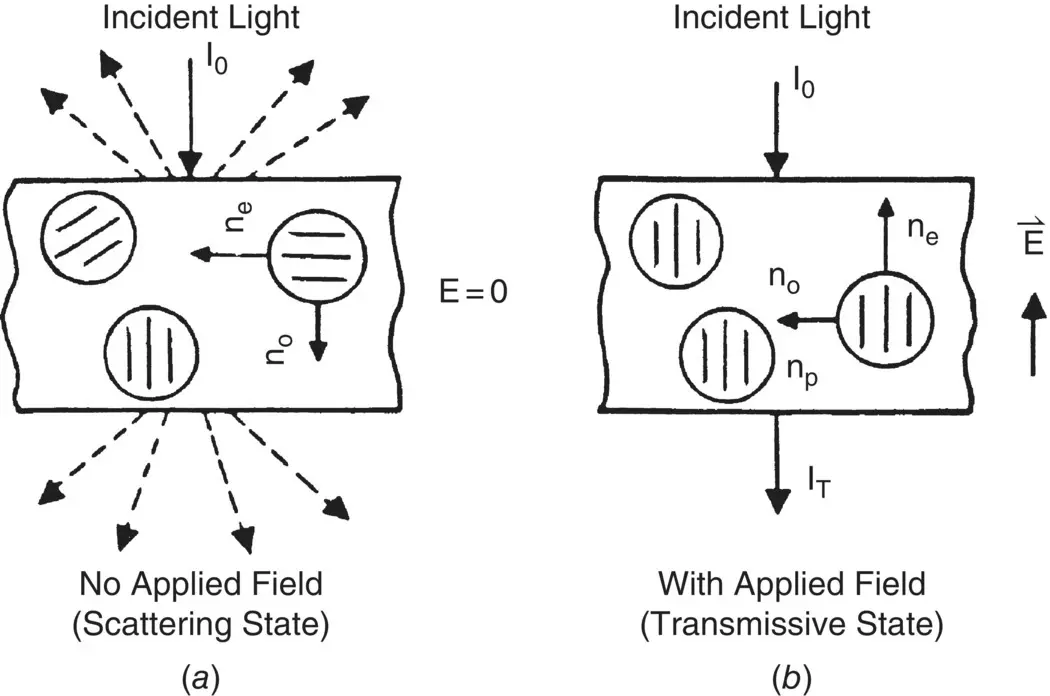
Figure 1.18. Schematic depiction of a polymer‐dispersed liquid crystal material: (a) in the absence of an external alignment field, highly scattered state; (b) when an external alignment field is on, transparent state.
There are now many techniques for preparing such polymer‐liquid crystalline composite, including the phase separation and the encapsulation methods [2, 19] for PDLC, and optical holographic interference methods [20–22] for making PDLC photonic crystals and grating [23, 24] have also demonstrated 1‐D polymer/liquid crystal layered structures that exhibit high diffraction efficiency as well as laser emission capabilities.
Another type of polymer‐liquid crystal “composite” is formed by mixing liquid crystal with monomer and subject the mixture to UV light. The rigid polymer network that results from the curing of the monomer follows the liquid crystal order and is able to extend the temperature range of the mesophase. This procedure has been employed to extend the temperature range of BPLCs from a few degrees to over 60° [25], for example.
1.5. LIQUID CRYSTAL CELLS FABRICATION
Liquid crystals, particularly nematics, behave physically very much like liquids. Owing to the random scattering of light caused by thermal fluctuations of the anisotropic constituent molecules, bulk unaligned nematic liquid crystals take on a milky appearance. They become crystal clear when confined in thin cells where the director axis of the bulk is controlled and aligned by strong anchoring forces from the cell boundaries that are treated in a variety of ways. Such surface alignment techniques and the underlying science are understandably very complex; the following discussions are intended as an introduction to some common practices.
1.5.1. Nematic LC Cells Assembly
For nematics, two commonly used alignments are the so‐called homeotropic and homogeneous (or planar) alignments, as shown in Figure 1.19a and b, respectively. To create homeotropic alignment, the cell walls are treated with a surfactant such as HTAB (hexadecyl trimethyl ammonium bromide) [26]. These surfactants are basically soaps whose molecules tend to anchor themselves perpendicular to the wall and thus impart homeotropic alignment to the bulk liquid crystal molecules.
Industrial processing of liquid crystals‐based devices or display screens, including various transparent conductive coating of the cell windows for electro‐optical applications, is understandably more elaborate, often held as proprietary information or patents. In the laboratory, a quick and effective way to make a homeotropic nematic liquid crystal is as follows: dissolve 1 part of HTAB in 50 parts of distilled deionized water by volume. Clean two glass slides (or other optical flats appropriate for the spectral region of interest). Dip the slides in the HTAB solution and slowly withdraw them. This effectively introduces a coating of HTAB molecules on the glass slides. The glass slides should then be dried in an oven or by other means. To prepare the nematic liquid crystal sample, place a spacer (Mylar or some nonreactive plastic) of desirable dimension and thinness on one of the slides. Fill the inner spacer with the nematic liquid crystal (which should be heated to the isotropic phase), and immediately place the second slide on top and secure the two slides with a clip. Once assembled, the sample should be left alone, and it will slowly (in a few minutes) settle into a clear homeotropically aligned state.
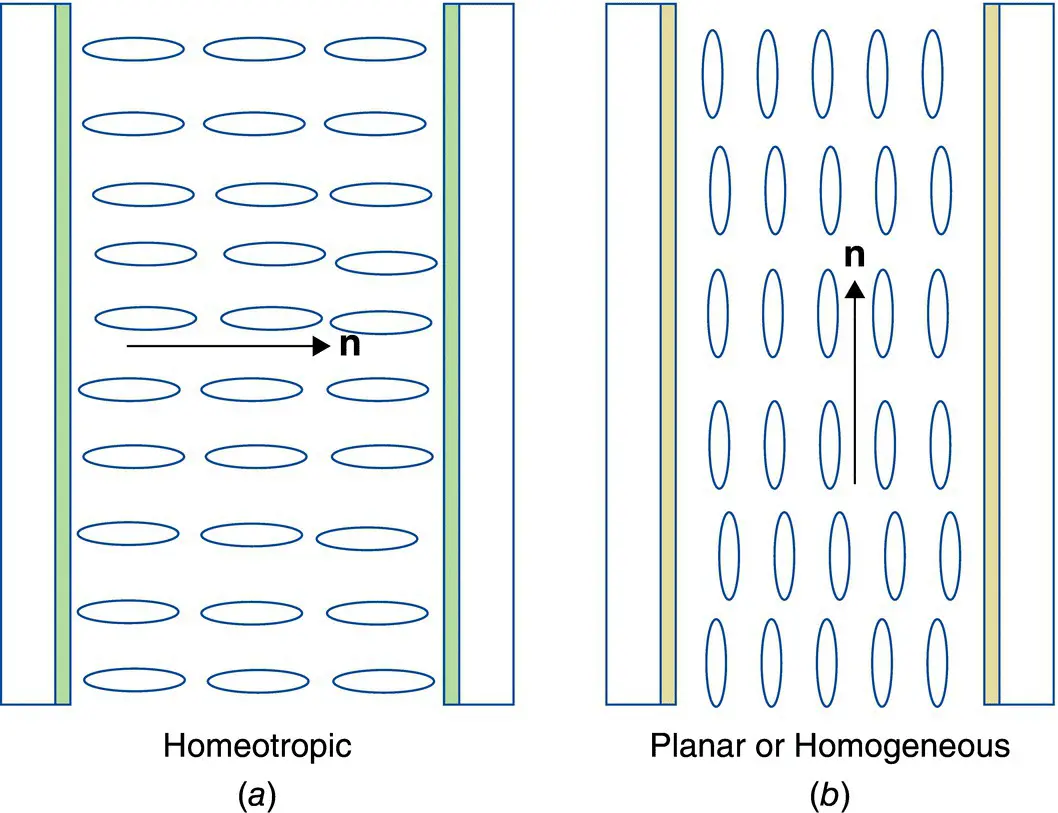
Figure 1.19. Nematic liquid crystal cells: (a) homeotropically aligned; (b) planar or homogeneously aligned.
Planar alignment can be achieved in many ways. A commonly employed method is to first coat the cell wall with some polymer such as PVA (polyvinyl alcohol) and then rub it unidirectionally with a lens tissue. This process creates elongated stress/strain on the polymer and facilitates the alignment of the long axis of the liquid crystal molecules along the rubbed direction (i.e. on the plane of the cell wall). As a matter of fact, there is a commercial so‐called rubbing machine for preparing planar cell windows. Another method is to deposit silicon oxide obliquely onto the glass slide.
For preparing a PVA‐coated planar sample in the laboratory, the following technique has proven to be quite reliable. Dissolve chemically pure PVA (which is solid at room temperature) in distilled deionized water at an elevated temperature (near the boiling point) at a concentration of about 0.2%. Dip the cleaned glass slide into the PVA solution at room temperature and slowly withdraw it, thus leaving a film of the solution on the slide. (Alternatively, one could place a small amount of the PVA solution on the slide and spread it into a thin coating.) The coated slide is then dried in an oven, followed by unidirectional rubbing of its surfaces with a lens tissue. The rest of the procedure for cell assembly is the same as that for homeotropic alignment.
Ideally, of course, these cell preparation processes should be performed in a clean room and preferably in an enclosure free of humidity or other chemicals (e.g. a nitrogen‐filled enclosure) in order to prolong the lifetime of the sample. Nevertheless, the liquid crystal cells prepared with the techniques outlined above have been shown to last several months and can withstand many temperature cycling through the nematic–isotropic phase transition point, provided the liquid crystals used are chemically stable. Generally, nematics such as 5CB and E7 are quite stable, whereas MBAA ( p ‐methoxybenzylidene‐ p′ ‐ n ‐butylaniline) tends to degrade in a few days.
Читать дальшеИнтервал:
Закладка:
Похожие книги на «Liquid Crystals»
Представляем Вашему вниманию похожие книги на «Liquid Crystals» списком для выбора. Мы отобрали схожую по названию и смыслу литературу в надежде предоставить читателям больше вариантов отыскать новые, интересные, ещё непрочитанные произведения.
Обсуждение, отзывы о книге «Liquid Crystals» и просто собственные мнения читателей. Оставьте ваши комментарии, напишите, что Вы думаете о произведении, его смысле или главных героях. Укажите что конкретно понравилось, а что нет, и почему Вы так считаете.
